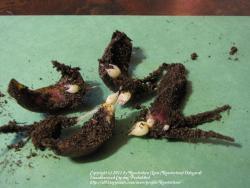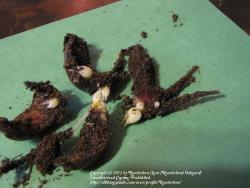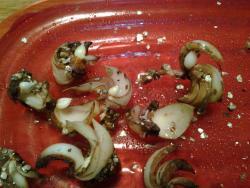Hi Brian: My approach is very much like Leftwoods, perhaps even more casual and laid back. Over time I've learned what works good enough for me; things I really have to pay attention to, and things I don't. I use whole scales whenever possible. Even outer scales if they are fresh. I never rinse them with fungicide or bleach. I do let them dry at least one day away from sun and heat. And I like to pasteurize my soil/media mix. I don't use growth stimulants and I shy away from any part of potting mix that are usually nutrient fortified. I use mainly a mix of my own garden soil and milled moss. I don't do any slice and dice cloning since i'm only going after a few and not several. I deal mainly with Trumpet cross seedling cloning.
Below is a picture of a couple from a scaling excersize I did with my 5 yr old Grand Daughter last fall. That gives you the Idea of how I do it. She wanted to look at them and take pictures to show here little buddies and teacher. They were about 5 weeks along at this point and were put back in the ziplock bag ( with sterile tweezers here) to finish.
This picture tells me alot. It tells me my moisture contents a little high, my temperature was a little high and my nutrient content is a little high. I can say that because the root system is a little too far advanced for mid point progress. My goal is to have the clone use up all of the mother scales energy rather than support itself, leaving the mother scale to rot. No water droplets were seen inside the bag because the higher temp allowed the higher dewpoint to mask it, so the bag was left open a couple more days, then allowed to finish before refigeration.
See the 5 largest bublets? I call those 'hogs'. They will hog the mother scales nutrients at a much faster rate during the last couple weeks and the 'runts' will most often dissappear.
Brian, I think in the end, you'll develope your own system that works for you and what you're trying to achieve. My info is just for background.




